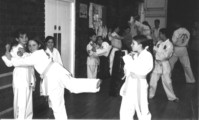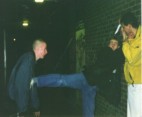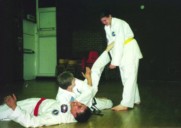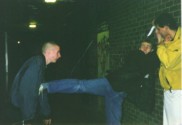Grappling techniques have been pushed to the forefront of martial arts training recently,
which is certainly not a bad thing, as is recognizing the fact that the
majority of fights end up in a grapple, wether vertically or horizontally. The style of martial arts that I consider my base is Taekwon-do, known preliminary as an impact based martial art, where strikes are the focal point. As with any martial art there are parts that are trained more and other aspects that are trained not so much, or even not at all. One of my instructors recognized this many years ago and having friendships with a few Jiu-Jitsu instructors he brought grappling and pressure points (back) into the dojang and encouraged us to attend Jiu-Jitsu seminars to further practice our grappling techniques. These techniques, as well as the judo I did while at college I still practice today & incorporate into both my own and my students training. Often the separate entities of our arts are trained as such: separate. Striking techniques, vertical grappling and throws, restraints or groundwork. But in self defence all of the following merge into one and the practitioner should be able to use the multitude of techniques cohesively. It seems today that kicking seems to be frowned upon a little where self defence is concerned. I am not here to tell you what is wrong or right, when to kick or when not to, but to (hopefully) open a few eyes to merging kicking and grappling together as part of your self defence training. First and foremost it must be said that I do not consider myself a superb grappler, only adequate. In a perfect situation I'd rather utilize strikes and kicks to defend myself since I subscribe to the 'hit and run' theory of self defence (where applicable), but there is never a perfect situation. In reality the last place I want to be with an aggressor is where I can smell their bad breathe and see their nostril hair. In a one on one confrontation, a pre-emptive strike may work, failing this a hand or finger strike may hold the answer whilst in some sort of vertical grapple, if it all goes pear shaped and you end up on the floor then a decent bit of groundwork may work it out for you, which should of course involve striking. Of course taking into account that muggers often work in pairs and most people don't go out drinking alone, plus that fact that most floors in bars, pubs and clubs can be slippery and contain broken glass etc. then the floor is the last place I want to end up on. Even if you were involved in a fight that started as a one on one do you really think that the guys mates are going to stand around while you ground and pound him, of course not. Do not assume that all multiple attackers attack at exactly the same time. Of course they don't line up and attack in a queued and orderly fashion as they do in the movies, but there is usually a leader and a follower or followers. By this I mean that the leader is the one that will initiate an attack, whether it be by a strike (physical) or as the one whom may start an argument (verbal), the follower on the other hand is the one who 'follows' the leaders 'lead'. The key to multiple attackers is to take players out the game as quickly as possible. This area of pre-emptive strikes and hit and move tactics have been discussed before so I won't repeat what more qualified people than myself can teach you. The area I'm going to deal with is when your in a vertical grapple, with two or more opponents. Obviously if there is time and you have the skills you could dispose of one with either a strike or a throw, then turn and deal with the second. But in a situation like this time is usually very limited and whilst you are tussling for control with one aggressor another is rushing up behind you to help out his mate. As is usually the case whilst grappling both hands are in use trying to control an aggressor. This is where your kicking skills can come in useful. The hardest parts being, firstly seeing the second attacker and secondly utilizing a kick whilst retaining balance. One important point I should note here is this. High kicks are often frowned upon in a street situation. This is because of the balance factor. However, if you are in a vertical grappling position, often it is the hands and arms doing the work. This being the case you will possibly find one or even two extra anchor points to help maintain balance while a fast kick is executed, with the emphasis being on fast, as using a struggling human as an anchor is still quite difficult, but hopefully their mind will be more on protecting themselves from your defence than actually continuing attacking, because if someone has a tight grip on your throat, survival instincts will dictate that you try remove it above all else. Examples Your attacked by a knifeman (thug) and you manage to get control of the arm and apply a claw squeeze technique to the throat, at the same time looking around for secondary attackers (not easy I know). You notice his mate coming up behind you out the corner of eye. You can't let go of the knife hand as this could be fatal and you can't let go of his throat as then he'll be back in the game and possibly free himself to continue the attack. So as the secondary aggressor rushes in you perform a quick, but solid back kick, using your other leg and your first opponent to help balance (see photo 1). At the very least it may push your second opponent back and stun them enough for you to deal with the first opponent (possibly allowing a pivotal few seconds for unconsciousness to take effect), or if hard enough it may knock the wind out of the second opponent or knock him to the floor, either way giving another vital few seconds to finish off or throw the first attacker and escape. I feel a mid section kick is better in this sort of situation as a kick to the knee may do more damage but its a much smaller target to hit. Of course after the back kick you have the maximum distance to bring the leg back in for a knee on the first opponent . A really skilled kicker might choose to do a hooking kick, with the ideal end result being the same as a hook punch on an unprepared attacker i.e. K.O. Even a miss with the sole of the foot travelling across the second attackers face might be enough to make him think twice (utilizing to good effect the 'WOW' factor) , again using the first opponent to provide a limited form of stability. Of course there are many variations that can be used and things get even more complicated when there are three or more attackers, but then again even a flash looking kick that does no damage at all can contain that 'WOW' factor that says 'Opps we've messed with wrong bloke this time'. Training for this type of situation should incorporate live opponents, as well as kick shields and possibly body protectors (as no one really wants a full power back kick to the gut). As well as the actual grapple and strikes. Students have found that using the first opponent as an anchor or base allows them to maintain equilibrium (kyun hyung) and actually helps to increase the power of your kick as you have something to push off. Also the reaction force (bandong ryok) is increased considerably by the second attacker rushing in, so even a mid power back kick will do a fair bit of damage. Awareness training should also be practised so that the defender will become accustomed to fighting and being aware for secondary attackers at the same time, remembering that with the increased adrenaline levels that a fight causes, tunnel vision becomes a side effect, making it imperative to actually turn your head rather than just using the corner of your eyes and it is imperative that this is performed in training. Other variations will include practising from various chokes or locks applied by the defender, practising whilst in a choke or lock applied by the attacker (following up with a release or strike on the attacker themselves) and practising with the lights off (or dimmed) to impede the visual scanning for secondary aggressors. Also practice against more than two attackers. Similar practice can and should be applied while practising horizontal grappling. This sort of situation is not easy so the more you practice the better you'll do should it arise. |
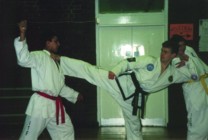
ARTICLES Grappling For kicks by Stuart Anslow III As printed in Taekwon-do & Korean Martial Arts Magazine (August 2001 Issue) |
GO TO |


SECTION 1 |
GO TO |

